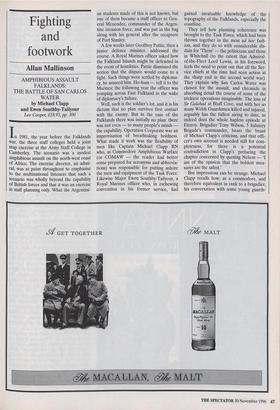Fighting and footwork
Allan Mallinson
AMPHIBIOUS ASSAULT FALKLANDS: THE BATTLE OF SAN CARLOS WATER by Michael Clapp and Ewen Southby-Tailyour Leo Cooper, £18.95, pp. 300 In 1981, the year before the Falldands war, the three staff colleges held a joint map exercise at the Army Staff College in Camberley. The scenario was a modest amphibious assault on the north-west coast of Africa. The exercise director, an admi- ral, was at pains throughout to emphasise to the multinational listeners that such a scenario was wholly beyond the capability of British forces and that it was an exercise In staff planning only. What the Argentini- an students made of this is not known, but one of them became a staff officer to Gen- eral Menendez, commander of the Argen- tine invasion force, and was put in the bag along with his general after the recapture of Port Stanley.
A few weeks later Geoffrey Pattie, then a junior defence minister, addressed the course. A Royal Marines officer asked how the Falkland Islands might be defended in the event of hostilities. Pattie dismissed the notion that the dispute would come to a fight. Such things were settled by diploma- cy, he assured him. Ho-hum — tell it to the Marines: the following year the officer was yomping across East Falkland in the wake of diplomacy's failure.
Well, such is the soldier's lot, and it is his dictum that no plan survives first contact with the enemy. But in the case of the Falklands there was initially no plan: there was not even — to many people's minds — the capability. Operation Corporate was an improvisation of breathtaking boldness. What made it work was the flexibility of men like Captain Michael Clapp RN who, as Commodore Amphibious Warfare (or COMAW — the reader had better come prepared for acronyms and abbrevia- tions) was responsible for putting ashore the men and equipment of the Task Force. Likewise Major Ewen Southby-Tailyour, a Royal Marines officer who, in eschewing convention in his former service, had gained invaluable knowledge of the topography of the Falklands, especially the coastline.
They tell bow planning coherence was brought to the Task Force, which had been thrown together in the most ad hoc fash- ion, and they do so with considerable dis- dain for 'Them' — the politicians and those in Whitehall (to the extent that Admiral- of-the-Fleet Lord Lewin, in his foreword, feels the need to point out that all the Ser- vice chiefs at the time had seen action at the sharp end in the second world war). They -explain why San Carlos Water was chosen for the assault, and chronicle in absorbing detail the course of some of the trickiest operations imaginable. The loss of Sir Galahad at Bluff Cove, and with her so many Welsh Guardsmen killed and injured, arguably has the fullest airing to date, as indeed does the whole hapless episode at Fitzroy. Brigadier Tony Wilson, 5 Infantry Brigade's commander, bears the brunt of Michael Clapp's criticism, and that offi- cer's own account is needed still for com- pleteness, for there is a potential contradiction in Clapp's prefacing the chapter concerned by quoting Nelson — 'I am of the opinion that the boldest mea- sures are the safest.'
But impressions can be strange. Michael Clapp recalls how, as a commodore, and therefore equivalent in rank to a brigadier, his conversation with some young guards- men was broken up by two senior NCOs: Brigadiers apparently do not speak to private soldiers [does this include, one won- ders, Royal Marines brigadiers?] . . . a revealing incident that contrasted dramatical- ly with the behaviour of Antelope's ship's company when I went down to talk to them. This, to me, highlighted, once more, the vast differences between the naval and military.
Curious, that.
The book tells as much about the people as the events, for the people were the events in so close-run a thing as that war. It ought, indeed, to carry a health warning along the lines of Dr Johnson's assertion that every man will think meanly of himself for never having been to sea (nor having been a soldier).
Montgomery had a portrait of Rommel in his planning caravan in the desert: study- ing it, he said, gave him insights into his enemy's intentions. On the back cover of this book is a three-quarter-length studio portrait of Commodore Clapp in 'Number Ones' (and why not?). An Argentine com- mander might have gained insights by con- templating it, especially if he had known of Michael Clapp's own principles of fighting imparted by 'one of my few heroes', his old boxing coach at Marlborough: 'If they fight, box them; if they box, fight them.' This book is a fascinating account of some very professional boxing and some bruising bare-knuckle fighting too.



















































































 Previous page
Previous page